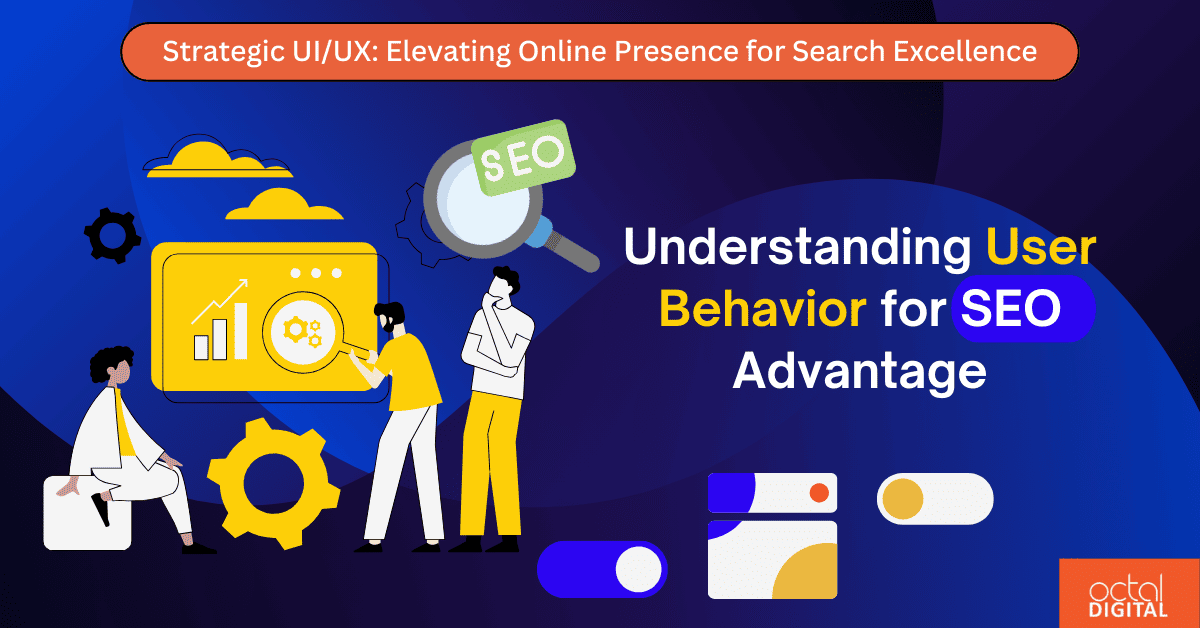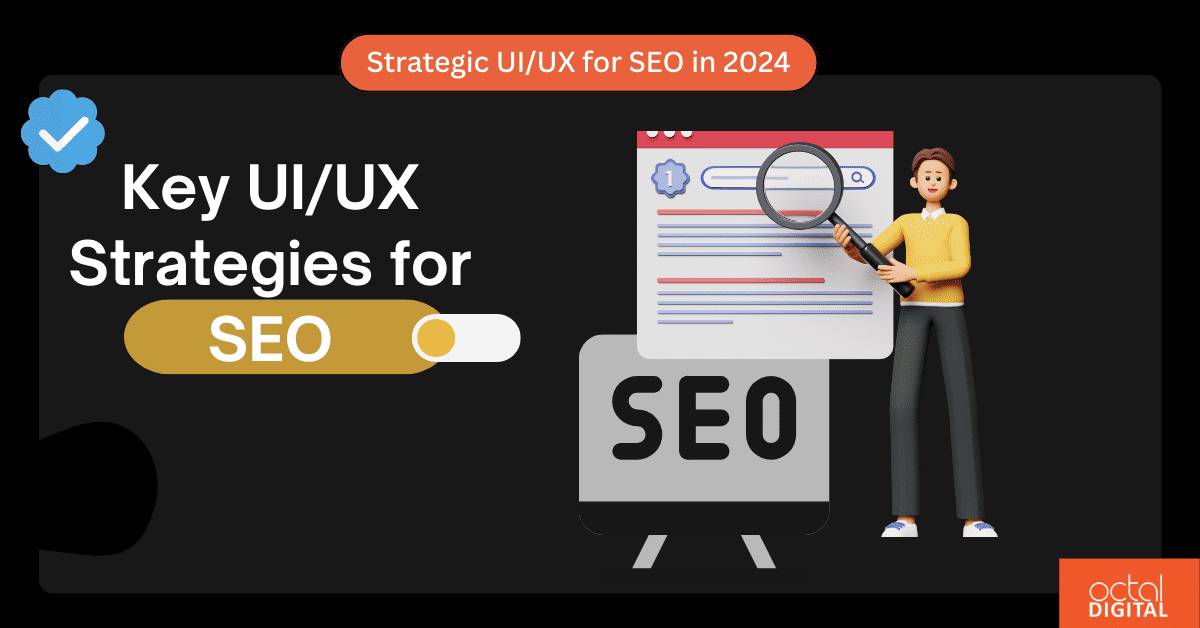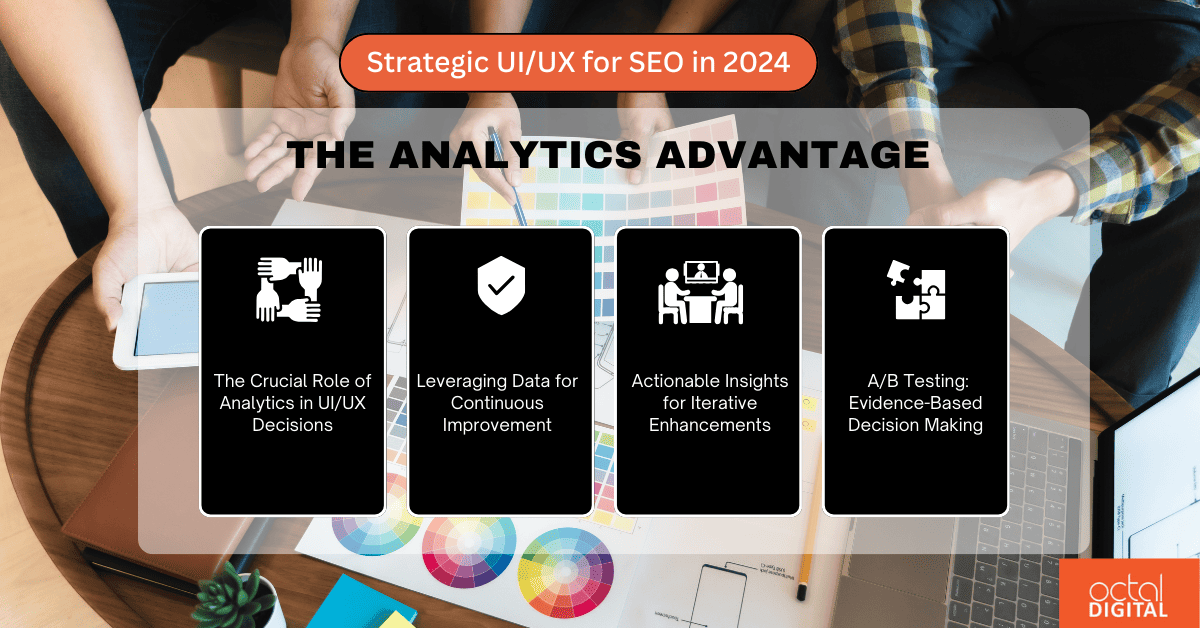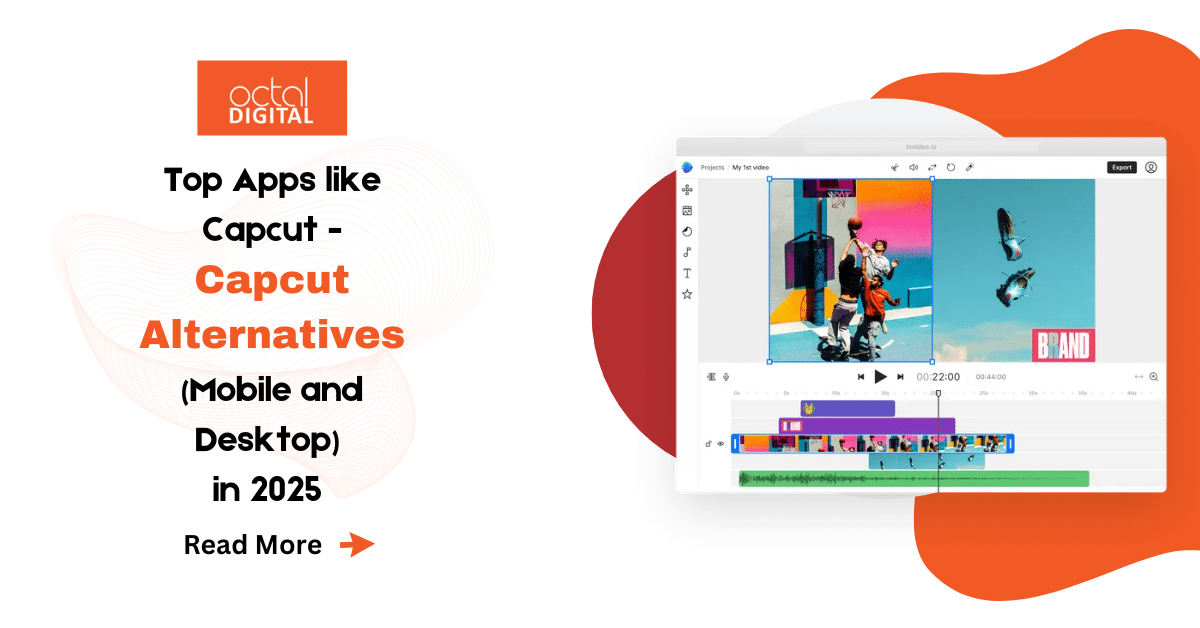Accessibility of any online web app is a major factor for user retention. A sophisticated user navigation page is always preferred over an aesthetic-hard-to-use web page design. UI/UX design is not solely focused on the aesthetic side of the user interface—rather it is the key determinant for the visibility and impact of a business’s digital footprint. Interactivity in the UI/UX and how the users’ behavior encourages more clicks contribute immensely to the overall web presence of your business entity.
It’s also important to note that one can imagine making a design change of just a button on the home page, and it can make a big difference to how many people click it. Google even has a Google checklist stating how the parameters of the web elements are developed to meet SEO standards and then ranks it.
Let’s explore them one by one in more detail:
Table of Contents
ToggleThe Synergy Between UI/UX and SEO

User Interface (UI) and User Experience (UX) design is beyond mere aesthetics—it plays a crucial role in influencing the visibility and impact of a digital presence. The symbiotic relationship between UI/UX and how the user behavior triggers more clicks gives a huge boost to the online presence of any business. A simple design change in a button on the home page can hugely impact how many people actually click it. In fact, Google itself makes a checklist of how the website elements are designed for SEO purposes and ranks it accordingly. Let’s explore them one by one in more detail:
-
Impact on Search Rankings:
UI/UX is a key factor in the usability process through which search engines assess and rank websites. The smooth navigation from one link to the other, quicker page access, and overall general user flow positively impact search engine algorithms. It is beneficial for not only effective user engagement but also in occupying an important place among the companies to create a brand image with a strong web presence.
-
User-Centric Design as a Ranking Factor:
Search engines increasingly prioritize user-centric design as a key ranking factor. It is synonymous with the idea that each year, search engine algorithms pay more and more importance to the usefulness of layouts for users. Their formula reveals that the sites that create greater value for their users, that is, the sites that provide a good UI/UX to users, shall have greater rankings, compared to a website that might be useful but lacks modern design. It reflects the need to involve more strategic UI/UX planning than just the frontend aesthetics to improve users’ journeys and interactions.
-
User Experience as a Metric of Relevance:
Search engines observe any interaction within the internet platforms to determine the relevance of any content posted. The longer the users remain fixated on the page content, the more search engines figure out the relevancy regarding the value of the content. This proves that the UI/UX plays a significant role in engaging the users while making a site more valuable to the eyes of the search engine. As a thumb rule, the better the user retention, the better is the SEO ranking.
Understanding User Behavior for SEO Advantage

SEO optimization strategies are tightly linked to online users’ behavior. To better understand the psychological factors behind user action and effectively design UI/UX, the following is a breakdown of the key takeaways to inform the strategies.
User Intent Dictates Rankings:
- Most search engines rely on keyword matches and evaluate content based on users’ interests. Users enter queries and they expect search engines to respond to their query.
- #TIP: Ensure you do keyword research to know what the user is searching for so that such content can be posted according to the query.
Dwell Time Matters:
- Some factors such as; dwell time which refers to the actual time spent by the user on the specific web page influence the ranking, and should be optimized. If a user spends more time on a page, it can be proof of the relevance and value of the provided content.
- #TIP: It involves optimization of the content to reach more users, engage them, and help retain the users on the page. Reducing the page load time is also a great optimization tip since it will avoid user frustration.
Click-Through Rate (CTR) and Rankings:
- A high CTR means the user finds a particular search result appealing compared to all other results. It is a major advantage valued by search engines and shows that the site is relevant to the context.
- #TIP: Use proper meta titles and descriptions to optimize the CTR. It’s also a good idea to accurately skim the content to ensure that they are accurate.
Mobile Friendliness is Non-Negotiable:
- Mobile internet browsing is dominant today! In this regard, search engines consider that people now spend more time with their mobile devices than on their computers. Thus, the mobile view of your page should be optimized for the mobile resolution, similar to your desktop view.
- #TIP: Ensure you figure out how to resolve responsive design issues well and across devices. The page should have a fast loading speed, optimized for mobile navigation.
Bounce Rate and User Satisfaction:
- A high bounce rate, where users visit a page but quickly leave, may indicate that the content could be more helpful or presented better. This can be detrimental because search engines might interpret it as lower user satisfaction.
- #TIP: Develop the content objectively – aim to provide concrete, informative information for readers. Enhance the site structure and design in such a way as to gain easy access to every link or webpage.
Are you prepared to take your brands’ engagement to the next level by creating user-focused experiences with seamless across-platform transitions? Collaborate with Octal Digital, a cutting-edge web design agency in the USA. Leverage the effectiveness of our UI/UX experts embedded in detail-oriented web designs along with successful SEO elements integration. Our expert team takes pride in implementing various technical standards to enhance your website’s digital presence, ensuring it gets the hits it deserves.
Key UI/UX Strategies for SEO

Let’s delve into the technical details of essential strategies:
A. Mobile Optimization: Beyond Responsiveness
-
Evolving Mobile Search Landscape:
A tremendous increase in mobile searches has been noted — a factor that calls for a holistic mobile responsiveness strategy. Of course, responsiveness is only a part of the solution but it is a matter of ‘adaptive’ interface design that addresses the overall mobile usage trends.
-
Tips for a Seamless Mobile Experience:
- Prioritize Mobile Speed: Use image compression, enable browser cache, and avoid multiple redirects for fast mobile page load.
- Finger-Friendly Design: Check button labels and ensure links are clear; make sure they are easily reachable using touch navigation.
- Accelerated Mobile Pages (AMP): Use AMP where there is more content as it increases the speed. It also improves the users’ experience.
B. Speed Matters: Enhancing Page Load Performance
-
Critical Role of Page Speed in SEO:
Factors such as page speed greatly affect user satisfaction and search engine rankings. Key factors that affect search engines include the website’s loading time since there is a direct relation between website speed and user satisfaction.
-
Practical Solutions for Improved Loading Times:
-
- Optimize Images: Compress images without compromising quality to reduce file sizes.
- Minimize HTTP Requests: Reduce coding and use and eliminate the usage of excess scripts for loading while supporting browser caching.
- Content Delivery Network (CDN): This is a technique where content is hosted across several servers globally to reduce the delay in display and improve the time taken to load the content. The heavier content like images loads little later, while text loads first, giving an impression-loaded web page to the user.
C. Navigation Nirvana: Enhancing User Journeys
-
Significance of Intuitive Navigation:
Navigation is considered one of the most critical elements of user satisfaction and search engine optimization. Users should be easily able to navigate a site in search of something specific. If searching for something is complex or delayed, the user will ideally not spend more time on the site and leave the site shortly i.e. reducing bounce rates.
-
Best Practices for User-Friendly Navigation Systems:
- Clear Hierarchy: The information should be presented so that a user can comprehend the presentation when the information is organized with a clear and logical structure.
- Mobile-First Navigation, Subsequently, it was noticed that as more and more people access the site through their mobile devices, navigation must be adapted to mobile-first.
- Breadcrumb Navigation: Maintains a proper database for navigation so that breadcrumbs can be implemented easily while the search engine crawling process can also be eased up to a great extent. Add a table of contents too, in content-related pages like blogs or articles.
Read Our Latest Blog: The Role of AI in Mobile Game Development 2024
D. Content Accessibility for Humans and Machines
-
Importance of Accessible Content:
Friendly URLs are useful for intent-based ranking. It enhances the user experience and aligns with the algorithms used by the search engines.
-
Guidelines for Balanced Content Creation:
-
- Descriptive Headings: Employ clear and logical hierarchical headings to define the content and its type.
- Alt Text for Images: Write functional descriptions that are short enough to help optimize your site.
- Semantic HTML: Adopt semantic HTML tags with references for clear content structures and easy understanding by search engines.
E. Visual Appeal and SEO Harmony
-
Impact of Visual Elements on Engagement:
This concept focuses on the aesthetics of the design and its impact on the consumer. Achieving a balance between aesthetics and the entailing SEO factors for a holistic strategy is crucial.
-
Insights into Balancing Aesthetics and SEO:
-
- Image Optimization: Optimize images, utilize responsive pictures, and provide short descriptions of the picture’s file name.
- Responsive Design: Design elements like images, graphics, icons, graphics, and other tools that are responsive to screen sizes. It enhances the look of the website, its aesthetics, and user experience.
- Image Sitemaps: Optimizing XML sitemaps and incorporating images in the documents improves the ability of search engines to index the site.
These technical skills will help achieve the goals of adopting a user-focused approach alongside improving SEO optimization. With our web development services, we always follow high coding standards for clean code structures, and provide a responsive design for improved accessibility. Octal Digital’s UI/UX and SEO implementation expertise will transform your digital presence. Well, are you ready to transform your digital journey now? Join us today, and let’s create a robust web solution.
Interactive Elements for Enhanced Engagement
Integrating interactive elements into the UI/UX design increases user interactions significantly. Let’s discuss the technical specifications and focus on real-life cases and successes.
| Sr. No | Topic | Technical Implementation | Example |
| 1 | Leveraging Interactive Elements in UI/UX Design | – HTML Structure: Develop a solid HTML structure with semantic tags. | – Dynamic Forms: Utilize JavaScript for real-time validation. |
| – CSS Styling: Apply visually appealing styles for components. | – Example: Adjust form fields dynamically based on user input. |
| 2 | Examples of Successful Interactive Implementations | – Dynamic Forms: Utilize JavaScript for real-time validation. | – Interactive Infographics: Use D3.js for data visualization. |
| – Interactive Infographics: Implement dynamic charts and graphs. | – Example: Explore data points and trends interactively. | ||
| – In-Page Sliders and Carousels: Use JS frameworks like Swiper. | – In-Page Sliders and Carousels: Enable touch gestures for mobile. | ||
| – Progressive Web App (PWA) Features: Utilize service workers. | – Example: PWA with offline functionality and push notifications. | ||
| – Interactive Maps: Integrate maps using APIs like Google Maps. | – Interactive Maps: Enable zooming, panning, and dynamic markers. | ||
| – Example: Explore locations and filter information. |
These interactive elements imply that they should be designed in such a manner that they are functionally prominent and at the same time aesthetically appealing. The technical implication, therefore, orients towards identifying and solving essential problems that hinder integration and performance. It becomes clear that, by applying each of them appropriately, the websites and applications will improve not only the level of SEO engagement but also provide more engaging and thus valuable interaction.
How Does Analytics Affect UI/UX Design Practices?

1. The Crucial Role of Analytics in UI/UX Decisions
Analytics remains a key driver in informing and shaping UI/UX decisions for offering an interactive flow based on users’ behavior. Thus, by analyzing the data collected, a designer will clearly understand how users engage with a particular platform and allow him/her to make proper decisions toward improving the user experience.
2. Leveraging Data for Continuous Improvement
Analytics can be useful in driving constant enhancement of the UI/UX by strategic use of analytics. User’s data analysis involves that designers revise and analyzed based on the user’s data by observing patterns and their preferences. It makes the process more proactive by catering to the changes in the UI/UX analyzed with real-world interaction of the end-users, and mitigating the issues that may create dissatisfaction.
3. Actionable Insights for Iterative Enhancements
Understanding user behavior by focusing on experiential and analytical data helps designers determine which improvements should be implemented in further iterations. When designers have insights about where people leave or bounce off the site, they can address those specific areas significantly and improve user retention.
4. A/B Testing: Evidence-Based Decision Making
Usability analytics is a crucial component of analytics. Coming from the same roots, A/B testing in UI elements means comparing elements’ performance with different perspectives. For example, the color of a button might perform better with a different color and animation, compared ta static button. This methodology compares two versions of a design to check which one suits better. Fundamentally, this approach helps designers improve the interface following hard-core research rather than guesswork, focusing on users’ preferences and behavioral forces that can influence a UI/UX design.
Recommended Read: UI/UX Principles: Best Guide for 2024
Emerging UI/UX Trends

A. Voice User Interfaces (VUI) and Conversational Design
- Voice search is rapidly becoming common and therefore now is the right time to start implementing it in SEO as many individuals prefer to use voice-activated commands for device navigation. Also, update keywords for natural language queries. Your website should also incorporate chatbots and virtual assistants to ensure user engagement.
B. Inclusive Design for Better Accessibility
- Concentrate on Inclusive Design and implement WCAG 2. 0 compliances. Design interfaces that are usable and responsive to those with disabilities, helps in improving inclusivity. Not to mention, web accessibility is important for the enhancement of the website by search engines.
C. Dark Mode Optimization
- As the usage of laptops, tablets, and other portable devices is very intensive, users want more comfort while reading content in conditions of low light. Thus, while dark mode has no explicit influence on SEO, the implementation of dark mode alongside its normal counterpart enhances the overall user experience, and, it positively impacts user engagement because it retains the users.
D. Accelerated Mobile Pages (AMP) for Improved Performance
- Fast-loading webpages play a great role in SEO. Therefore, focus on creating fast-loading pages because it especially matters to mobile users with low-end device configurations. Visit this https://pagespeed.web.dev/ to check your current page insights for SEO.
Enhance performance by the efficient code structures and CDNs to make page load faster and more swift. Our web designers, committed to adaptability and responsiveness, ensure that the design implementation fits well across devices for better usability. Trust comes first – Octal Digital accepts SSL certificates, conducts audits, and employs safe measures, with safety in mind.
Conclusion: Elevating Online Presence through UI/UX and SEO
We can see a strong and clear connection between the UI and UX design affecting online success. Besides being aesthetically pleasing, strategic UI/UX patterns promptly affect website indexing and SEO rankings. User-friendly designs play a vital role in search engines, making them more user-adaptive and enhancing user satisfaction. Analytics facilitate adaptive design with continuous improvement relevant to actual usage. Recent trends such as Voice User Interfaces (VUI), the relatively new Dark Mode, and Accelerated Mobile Pages (AMP) are also in tune with the dynamic digital environment. Although not bearing on SEO, these trends are of great importance to site functionality and usability, or User Experience (UX), on which the sustenance of online presence depends.
Staying relevant with flexibility and dedication to the users’ experience is crucial. We deliver some of the best WordPress development services and custom-made themes for your web solutions that speaks for your brand. Visit our ‘portfolios’ page and check out the variety of case studies in various sectors we offer!
FAQs
-
Why is mobile optimization crucial for UI/UX in the context of search excellence?
Mobile optimization is important, especially with the increasing number of people who turn to mobile browsers for quick search. in search quality. Mobile speed, finger-friendly design, and the usage of AMP sets as core aspects of this strategy have to be mentioned.
-
How does page speed impact both user satisfaction and SEO rankings?
Through theoretical analysis and practical examples, it is found that page speed is inherent in user satisfaction indexes and SEO rankings. It means that the fast-loading pages are ranked higher by the search engines and users enjoy the sites or services. The principles of image optimization, reduction of the HTTP requests, and CDN caching are still crucial to the performance of the page load.
-
What role does intuitive navigation play in the success of UI/UX and SEO?
Ease of navigation defines the website’s capability to meet visitors’ needs and rank high on the search engine results page. If the users can locate whatever they are looking for, this is favorable for user retention and lessens the bounce rates. To do this, the leadership should have a clear hierarchy; navigation should embrace the mobile-first approach; breadcrumb navigation should facilitate the improved search engine crawling technique.
-
Why is accessible content important, and how does it impact both users and search engines?
Accessible content is important because it provides content to the user and the search engines. It improves the accessibility for multidimensional users and complies with search engines’ tendency to rank only those websites that observe proper accessibility measures. Meaningful titles, appropriate image titles or descriptions, and HTML tags are used in balanced content creation.







